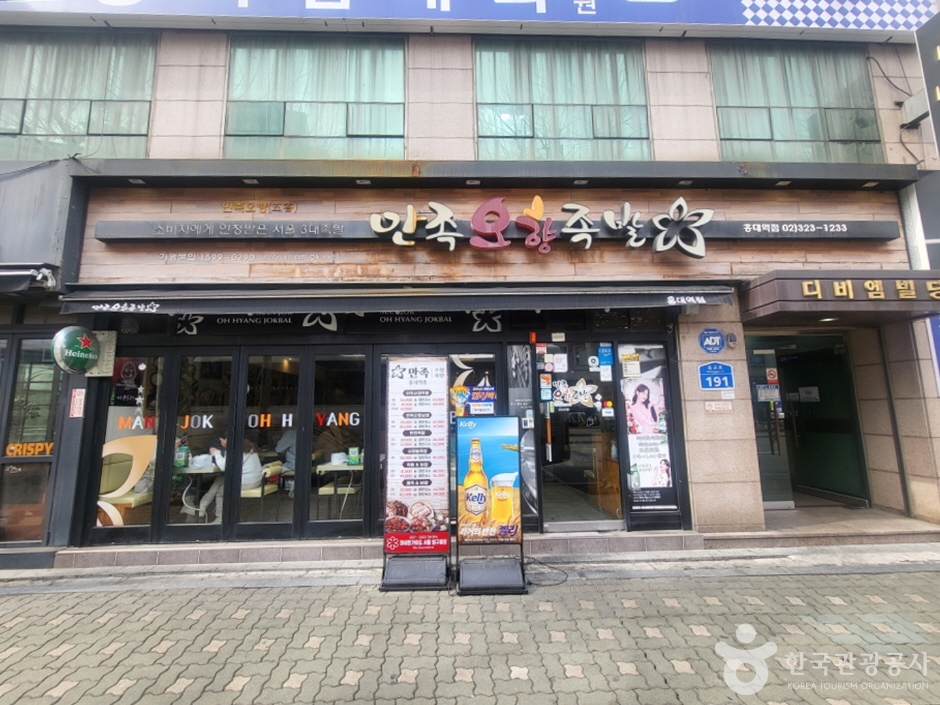Innisfree - Mia Samgeori Branch [Tax Refund Shop] (이니스프리 미아삼거리)
5.8Km 2024-04-22
31, Dobong-ro, Seongbuk-gu, Seoul
-
Myth Jokbal Hongik Univ. (미쓰족발 홍대)
5.8Km 2024-03-19
123-1 Eoulmadang-ro Mapo-gu Seoul
+82-2-336-2111
Myth Jokbal is an affordable place for jokbal (braised pigs' feet) and bossam (kimchi cabbage wraps with pork). Jokbal is made by boiling pork feet for a long time and is characterized by its chewy texture and flavor. The signature dish, Myth maneul jokbal (braised pigs' feet with garlic), is tender and flavored with plenty of garlic. the restaurant offers other popular dishes including original jokbal (original braised pigs' feet), kkaennip buljokbal (spicy braised pigs' feet with perilla leaves), and gabeuri bossam (kimchi cabbage wraps with grilled blade-end fatback). It is just a 2-minute walk from Exit 9 of Hongik Univ. Station, attracting numerous visitors.
Nature Republic - Homeplus Wolgok Branch [Tax Refund Shop] (네이쳐리퍼블릭 홈플러스월곡점)
5.8Km 2024-04-23
76, Hwarang-ro, Seongbuk-gu, Seoul
-
Olive Young - Homeplus Wolgok Branch [Tax Refund Shop] (올리브영 홈플러스월곡)
5.8Km 2024-04-17
Home Plus Wolgok Branch, 76, Hwarang-ro, Seongbuk-gu, Seoul
-
Homeplus - Wolgok Branch [Tax Refund Shop] (홈플러스 월곡)
5.8Km 2024-04-22
76, Hwarang-ro, Seongbuk-gu, Seoul
-
Aimerfeel - Hongdae Branch [Tax Refund Shop] (에메필 홍대점)
5.8Km 2024-04-16
#108, 156, Yanghwa-ro, Mapo-gu, Seoul
-
Olive Young - Hongik Univ. Station Branch [Tax Refund Shop] (올리브영 홍대입구역)
5.8Km 2024-04-16
156, Yanghwa-ro, Mapo-gu, Seoul
-
Gyeongui Line Forest Park (Yeontral Park) (경의선숲길(연트럴파크))
5.9Km 2023-08-11
133, Donggyo-ro 51-gil, Mapo-gu, Seoul
Gyeongui Line Forest Park is a linear city park located in Mapo-gu and is also called Yeontral Park. It includes Daeheung-dong, Yeonnam-dong, Saechanggogae Pass, Changjeon-dong, Sinsu-dong, and Wonhyo-ro, which were opened in this order. Gyeongui Line Forest Park is established atop the Gyeongui railroad line and the Gyeongui Line and Airport Railroad Express are constructed as a double track underground. Gyeongui Line Forest Park was designed to be incomplete on purpose to invite the citizens in completing the park. The area which could have been left empty and neglected has turned into a meaningful green park for the citizens by the citizens.
Manjok Ohyang Jokbal Hongik Univ.(만족오향족발 홍대)
5.9Km 2024-03-20
191 Donggyo-ro Mapo-gu Seoul
+82-2-323-1233
Located near Hongik Univ. Station, Manjok Ohyang Jokbal is said to be one of the top three jokbal (braised pigs' feet) restaurants in Seoul. Their signature dishes are manjog ohyang jokbal (braised five-spice pigs' feet), jokbal and jaengban guksu (jumbo sized buckwheat noodles) set menu. Manjok ohyang jokbal is made with pigs' feet marinated in five different sauce flavors, giving it a chewy texture and rich flavor. Bul jokbal (spicy braised pigs' feet) is a popular dish that can be paired with bossam (kimchi cabbage wraps with pork) or jokbal as a half and half set menu.
Eongteori Saenggogi Hongdae (엉터리생고기 홍대)
5.9Km 2024-03-19
118, Eoulmadang-ro, Mapo-gu, Seoul
+82-2-345-9588
Located near Hongdae, Eongteori Saenggogi is an all-you-can-eat restaurant that specializes in grilled beef and pork. Along with raw meats such as pork belly, pork shoulder, beef sirloin, and beef brisket, the restaurant offers dishes including cold buckwheat noodles, kimchi jjigae, and soybean paste jjigae. A variety of sauces, kimchi, vegetables, and other side dishes are available at the salad bar. The great thing is that if you order a bowl of steamed rice, you can serve it as much as you want.

![Aimerfeel - Hongdae Branch [Tax Refund Shop] (에메필 홍대점)](http://tong.visitkorea.or.kr/cms/resource/51/2887751_image2_1.jpg)

 English
English
 한국어
한국어 日本語
日本語 中文(简体)
中文(简体) Deutsch
Deutsch Français
Français Español
Español Русский
Русский